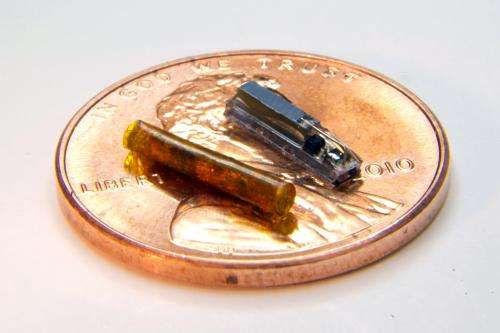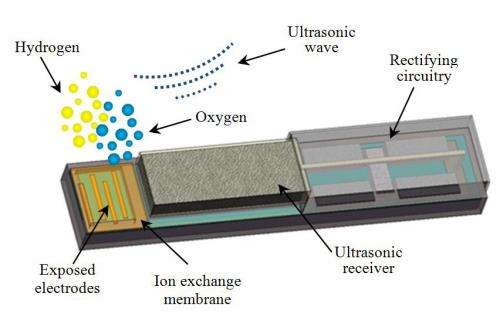Researchers have created and tested a miniature device, seen here, that can be implanted in tumors to generate oxygen, boosting the killing power of radiation and chemotherapy. The technology is designed to treat solid tumors that are hypoxic at the center, meaning the core contains low oxygen levels. The device (right) fits inside a tube (left) that can then be inserted into a tumor with a biopsy needle. (Birck Nanotechnology Center, Purdue University)
(Medical Xpress) -- Researchers have created and tested miniature devices that are implanted in tumors to generate oxygen, boosting the killing power of radiation and chemotherapy.
The technology is designed to treat solid tumors that are hypoxic at the center, meaning the core contains low oxygen levels.
"This is not good because radiation therapy needs oxygen to be effective," said Babak Ziaie, a Purdue University professor of electrical and computer engineering and biomedical engineering. "So the hypoxic areas are hard to kill. Pancreatic and cervical cancers are notoriously hypoxic. If you generate oxygen you can increase the effectiveness of radiation therapy and also chemotherapy."
The new "implantable micro oxygen generator" is an electronic device that receives ultrasound signals and uses the energy to generate a small voltage to separate oxygen and hydrogen from water – a chemical operation called water electrolysis.
"We are putting these devices inside tumors and then exposing the tumors to ultrasound," Ziaie said. "The ultrasound energy powers the device, generating oxygen.
The devices were created at the Birck Nanotechnology Center in the university's Discovery Park. Purdue researchers are working with Song-Chu (Arthur) Ko, an assistant professor of clinical radiation oncology at the Indiana University School of Medicine.
This diagram shows the design of a miniature device that can be implanted in tumors to generate oxygen, boosting the killing power of radiation and chemotherapy. (Birck Nanotechnology Center, Purdue University)
Researchers have tested the devices in pancreatic tumors implanted in mice, showing they generated oxygen and shrunk tumors faster than tumors without the devices. The devices are slightly less than one centimeter long and are inserted into tumors with a hypodermic biopsy needle.
"Most of us have been touched by cancer in one way or another," Ziaie said. "My father is a cancer survivor, and he went through many rounds of very painful chemotherapy. This is a new technology that has the potential to improve the effectiveness of such therapy."
Findings are detailed in a research paper appearing online this month in Transactions on Biomedical Engineering. The paper was written by research assistant professor Teimour Maleki, doctoral students Ning Cao and Seung Hyun Song, Ko and Ziaie.
"The implantable mini oxygen generator project is one of 11 projects the Alfred Mann Institute for Biomedical Development at Purdue University (AMIPurdue) has sponsored," Ziaie said. "AMIPurdue has been instrumental in providing the development funding of roughly $500,000 on this project. And beyond funding, the AMIPurdue team has also helped us with market research, physician feedback, industry input, as well as intellectual property and regulatory strategy. We have been able to accomplish a great deal in a short time due to the collaborative effort with AMIPurdue."
A patent application has been filed for the design.
Future work may focus on redesigning the device to make it more practical for manufacturing and clinical trials.
More information: An Ultrasonically-Powered Implantable Micro Oxygen Generator (IMOG), T. Maleki, N. Cao, S.H. Song, C. Kao, S.C. Ko, B. Ziaie
ABSTRACT
In this paper we present an ultrasonically-powered implantable micro oxygen generator (IMOG) that is capable of in situ tumor oxygenation through water electrolysis. Such active mode of oxygen generation is not affected by increased interstitial pressure or abnormal blood vessels that typically limit the systemic delivery of oxygen to hypoxic regions of solid tumors. Wireless ultrasonic powering (2.15 MHz) was employed to increase the penetration depth and eliminate the directional sensitivity associated with magnetic methods. In addition, ultrasonic powering allowed for further reduction in the total size of the implant by eliminating the need for a large area inductor. IMOG has an overall dimension of 1.2x1.3x8 mm^3, small enough to be implanted using a hypodermic needle or a trocar. In vitro and ex vivo experiments showed the IMOG is capable of generating more than 150 mA which in turn can create 0.525 ml/min of oxygen through electrolytic dissociation. In vivo experiments in a well-known hypoxic pancreatic tumor model (1 cm^3 in size) also verified adequate in situ tumor oxygenation in less than 10 minutes.
Provided by Purdue University





















